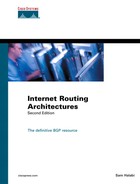Peer Groups
Peer groups can now be configured under specific AFs, providing a considerable amount of flexibility over the old style of configuring peer groups. This section discusses both the old and new methods of configuring peer groups.
Old Style
A peer group was defined in the BGP router configuration mode. The nlri keyword was used to allow the peer group to exchange multicast prefixes. Using the nlri keyword, you could specify unicast and/or multicast. If the nlri keyword was not specified, it implied only IPv4 unicast.
The peer group members automatically inherited the unicast and/or multicast capability of the peer group. The following command syntax shows the old method of configuring peer groups:
Router(config-router)#router bgp 10 Router(config-router)#neighbor external peer-group nlri unicast multicast Router(config-router)#neighbor 1.2.3.4 remote-as 20 Router(config-router)#neighbor 1.2.3.4 peer-group external
AF Style
The peer group (or its members) is (are) defined under the BGP router mode. However, because we have AF submodes, the need for the nlri keyword is obviated. The peer group needs to be activated in the IPv4 multicast AF to enable the exchange of IPv4 multicast prefixes. As with the neighbor command, a peer group and its members are activated by default for IPv4 unicast. This behavior can be overridden using the no form of the activate command. The following command syntax shows how to configure peer groups using the new AF-style CLI:
Router(config)#router bgp 10 Router(config-router)#neighbor external peer-group Router(config-router)#neighbor 1.2.3.4 remote-as 20 Router(config-router)#neighbor 1.2.3.4 peer-group external Router(config-router)#address-family ipv4 multicast Router(config-router-af)#neighbor external activate Router(config-router-af)#neighbor 1.2.3.4 peer-group external
